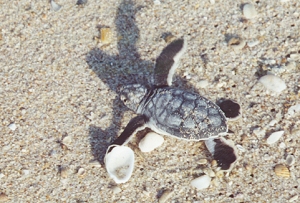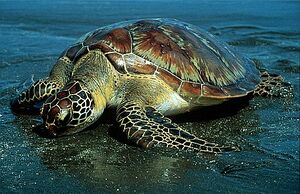Chelonia mydas
The Green Sea Turtle-Chelonia mydas

Kingdom: Animalia Phylum: Chordata Class: Reptilia Order: Testudines Family: Cheloniidae Genus: Chelonia Species: mydas
Description The green sea turtle grows to a maximum size of about 4 feet and a weight of 440 pounds (2). The green turtle is the largest of the Cheloniidae family. The largest green turtle ever found was 5 feet (152 cm) in length and 871 pounds (395 kg) (4). Has a heart-shaped shell, small head, and single-clawed flippers. Color in the turtles can vary. Hatchlings generally have a black carapace, white plastron, and white margins on the shell and limbs. The adult carapace is smooth, keelless, and light to dark brown with dark mottling; the plastron is whitish to light yellow (2). Adult heads are light brown with yellow markings. Identifying characteristics include four pairs of costal scutes, none of which borders the nuchal scute, and only one pair of prefrontal scales between the eyes. Hatchling green turtles eat a variety of plants and animals, but adults feed almost exclusively on seagrasses and marine algae (4).

Weight: 300-350 pounds (135-160 kg) for adults; hatchlings weigh 0.05 lbs (25 g) (1)
Length: 3 feet (1 m) for adults;hatchlings are 2 inches (50 mm) (1)
Appearance: top shell (carapace) is smooth with shades of black, gray, green, brown, and yellow; their bottom shell (plastron) is yellowish white
Lifespan: unknown, but sexual maturity occurs anywhere between 20-50 years
Diet: seagrasses and algae. Changes significantly during its life. When less than 8 to 10 inches in length eat worms, young crustaceans, aquatic insects, grasses and algae. Once green turtles reach 8 to 10 inches in length, they mostly eat sea grass and algae, the only sea turtle that is strictly herbivorous as an adult. Their jaws are finely serrated which aids them in tearing vegetation (4).
Behavior: females return to the same beaches where they were born ("natal" beaches) every 2-4 years to lay eggs, generally in the summer months
Habitat Green turtles primarily use three types of habitat: Beaches for nesting,open ocean convergence zones, and coastal areas for "benthic" feeding. Adult females migrate from foraging areas to mainland or island nesting beaches and may travel hundreds or thousands of kilometers each way. After emerging from the nest, hatchlings swim to offshore areas, where they are believed to live for several years, feeding close to the surface on a variety of pelagic plants and animals. Once the juveniles reach a certain age/size range, they leave the pelagic habitat and travel to nearshore foraging grounds. Once they move to these nearshore benthic habitats, adult green turtles are almost exclusively herbivores, feeding on sea grasses and algae (1). Range: Found in all temperate and tropical waters throughout the world (4).
Geographical Distribution The green turtle is globally distributed and generally found in tropical and subtropical waters along continental coasts and islands between 30° North and 30° South. Nesting occurs in over 80 countries throughout the year. Green turtles are thought to inhabit coastal areas of more than 140 countries (1). In U.S. Atlantic and Gulf of Mexico waters, green turtles are found in inshore and nearshore waters from Texas to Massachusetts, the U.S. Virgin Islands, and Puerto Rico. Important feeding areas in Florida include the Indian River Lagoon, the Florida Keys, Florida Bay, Homosassa, Crystal River, Cedar Key, and St. Joseph Bay (3). In the eastern North Pacific, green turtles have been sighted from Baja California to southern Alaska, but most commonly occur from San Diego south (2). In the central Pacific, green turtles occur around most tropical islands, including the Hawaiian Islands. Adult green turtles that feed throughout the main Hawaiian Islands undergo a long migration to French Frigate Shoals in the Northwest Hawaiian Islands, where the majority of nesting and mating occurs(1).
Two largest nesting populations for Green Sea Turtles are found in Tortuguero, on the Caribbean coast of Costa Rica, where 22,500 females nest per season on average and Raine Island, on the Great Barrier Reef in Australia, where 18,000 females nest per season on average (1).
Reproduction The nesting season varies with the locality. In the southeastern U.S., it is roughly June through September. Nesting occurs nocturnally at 2, 3, or 4-year intervals (3). Only occasionally do females produce clutches in successive years. A female may lay as many as nine clutches within a nesting season (overall average is about 3.3 nests per season) at about 13-day intervals. Clutch size varies from 75 to 200 eggs, with an average clutch size of 136 eggs reported for Florida. Incubation ranges from about 45 to 75 days, depending on incubation temperatures. Hatchlings generally emerge at night. Age at sexual maturity is believed to be 20 to 50 years (2).
Threats Harvesting of eggs and adults for food and other uses Incidental capture in fishing gear (longline fisheries)-Cause turtles to drown Fibropapillomatosis (disease)-Tumors Boat strikes Pollution in the water caused the turtles to become confused with their food and they eat the garbage The principal cause of the historical, worldwide decline of the green turtle is long-term harvest of eggs and adults on nesting beaches and juveniles and adults on feeding grounds. These harvests continue in some areas of the world and compromise efforts to recover this species. Incidental capture in fishing gear, primarily in gillnets, but also in trawls, traps and pots, longlines, and dredges is a serious ongoing source of mortality that also adversely affects the species' recovery.
For more information, please visit threats to marine turtles page (1). [4]
![[3]](http://images.shoutwiki.com/ashlandscience/6/60/Turtle.jpg)
Conservation In the U.S., NOAA Fisheries and the U.S. Fish and Wildlife Service (USFWS) have joint jurisdiction for green turtles, with NOAA having the lead in the marine environment and USFWS having the lead on the nesting beaches. Both federal agencies, and a number of state agencies, have promulgated regulations to eliminate or reduce threats to sea turtles. In the Atlantic and Gulf of Mexico, we have required measures (such as gear modifications, changes to fishing practices, and time/area closures) to reduce sea turtle bycatch in pelagic longline, mid-Atlantic gillnet, Chesapeake Bay pound net, and southeast shrimp and flounder trawl fisheries (1).
Additional Information
a. For more information on the pollutants and health of Green Sea Turtles check out this link: http://www.sciencedirect.com/science/article/pii/S0045653511004140
b. For more information on the long distance migration and homing of green sea turtles see: http://www.springerlink.com/content/h9467w12725g362v/
References (1) http://www.nmfs.noaa.gov/pr/species/turtles/green.htm (2) http://www.fws.gov/northflorida/SeaTurtles/Turtle%20Factsheets/green-sea-turtle.htm (3) http://www.earthtrust.org/wlcurric/turtles.html (4) http://www.conserveturtles.org/seaturtleinformation.php?page=green